Economics - Theories of Interest | 11th Economics : Chapter 6 : Distribution Analysis
Chapter: 11th Economics : Chapter 6 : Distribution Analysis
Theories of Interest
Theories
of Interest
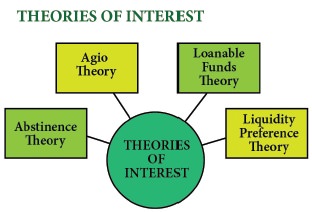
1. Abstinence Theory or Waiting Theory
This
theory was propounded by N.W.Senior. To him, interest is the reward for abstaining
from the immediate consumption of wealth. According to Senior, capital is the
result of saving. But saving involves “abstinence”
or “sacrifice”. It is possible to save only if one abstains from present
consumption. Such abstinence from present consumption involves some suffering.
Hence, it is necessary to reward the saver (capitalist) to compensate for the
sacrifice he has to undergo by abstaining from present consumption. Therefore,
interest is the reward or compensation paid to the saver (capitalist) for his
“abstinence” or “sacrifice”.
Marshall
accepted the Abstinence Theory of interest. But he used the word ‘waiting’
instead of “abstinence”. Saving implies waiting. According to him, interest is
the reward for waiting. Saving involves waiting. But people do not like to
wait. So, in order to make them wait and in turn to save, we have to pay them
some reward. Therefore, interest is the reward paid to the saver (capitalist)
for his “waiting”.
Criticism
According
to this theory, saving involves suffering. But savings may not always involve
suffering to some rich people. Rich people have money for which they do not get
interest. Hoarding of money is to quench the thirst for liquidity.
2. Agio Theory of Interest/ The Psychological Theory of Interest/Time Preference Theory
This
theory was propounded by John Rae in 1834. But credit goes to Bohm Bawerk an
Austrian School economist who has given final shape to the theory. The American
economist Irving Fisher modified and gave a new theory viz Time Preference
theory.
According
to this theory, people prefer present goods rather than future goods. Because
the present goods are more certain than future goods, just “as a bird in the hand is
worth two in the bush”. Ther are
many countries where no one knows what will happen next day.ASEAN crisis of 1996 and American crisis of 2007-08 were not
predicted even for economists, including Nobel Laureats. So, when people save
they have to postpone their present enjoyment or satisfaction. If one postpones
one’s present satisfaction, one has to be paid an “Agio” or “Premium”. This premium is “interest”. People prefer
present consumption than future consumption due to the risk increasing and
uncertainties of the present world.
3. Loanable Funds Theory/ The Neo Classical Theory
The
Loanable Funds Theory, also known as the “Neo–Classical Theory”, was developed
by Swedish economists like Wicksell, Bertil Ohlin, Viner, Gunnar Myrdal and
others.
According
to this theory, interest is the price paid for the use of loanable funds. The
rate of interest is determined by the equilibrium between demand for and supply
of loanable funds in the credit market.
Demand for Loanable Funds
The
demand for loanable funds depends upon the following:
Demand for Investment (I)
The most
important factor responsible for the loanable funds is the demand for
investment. Bulk of the demand for loanable funds comes from business firms
which borrow money for purchasing capital goods.
Demand for Consumption (C)
The
demand for loanable funds comes from individuals who borrow money for
consumption purposes also.
Demand for Hoarding (H)
The next
demand for loanable funds comes from hoarders. Demand for hoarding money arises
because of people’s preference for liquidity, idle cash balances and so on. The
demand for C, I and H varies inversely with interest rate.
Supply of Loanable Funds
The
supply of loanable funds depends upon the following four sources:
1. Savings (S)
Loanable
funds come from savings.
According
to this theory, savings may be of two types, namely,
·
Savings planned by individuals are called “ex-ante
savings”. E.g. LIC premium, EMI payment etc.
·
The unplanned savings are called, “ex-post
savings”. Savings is left out after spending are ex post saving.
2. Bank Credit (BC)
The bank
credit is another source of loanable funds. Commercial banks create credit and
supply loanable funds to the investors.
3. Dishoarding (DH)
Dishoarding
means bringing out the hoarded money into use and thus it constitutes a source
of supply of loanable funds. In India,after 1991,Public sector undertakings are
being sold to private people to mobilize more funds.This is also called
disinvestment.
4. Disinvestment(DI)
Disinvestment
is the opposite of investment.Inotherwordsdisinvestment means not providing
sufficient funds for depreciation of equipment. It gives rise to the supply of
loanable funds.
All the
four sources of supply of loanable funds vary directly with the interest rate.
Classical theory of Interest
The equilibrium interest rate, according to classical theory, is
determined by the intersection of demand and supply curves, Demand for money
refers to investment. Supply of money refers to savings S=I.
Equilibrium
The rate
of interest is determined by the equilibrium between the total demand for and
the total supply of loanable funds.
Supply of and Demand for Loanable Funds
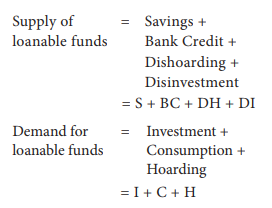
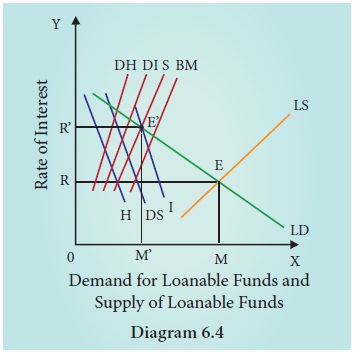
In
Diagram 6.4, X axis represents the demand for and supply of loanable funds and
Y axis represents the rate of interest. The LS curve represents the total
supply curve of loanable funds. This is obtained by the summation of the Saving
Curve (S), Bank credit curve (BC), Dishoarding curve (DH) and Disinvestment
curve (DI).
The LD curve represents the total demand for loanable funds;
this is obtained by the summation of the demand for investment curve I, demand
curve for consumption demand or dissaving curve and curve for demand for
hoarding curve H. The LD and LS curves, intersect each other at the point “E”
the equilibrium point. At this point, OR rate of interest and OM is the amount
of loanable funds.
Criticisms
1. Many
factors have been included in this theory.Still ther are many more factors.Two
such factors are 1)Asymmetric Information and 2) Moral Hazard.In practice
larger firms, due to their political powers, are able to get huge bank credit
at lower interest rates.But due to NPAs, (Non-Performing
Assets)small firms and depositors lose their interest income. The loanable
funds theory is “indeterminate”’ unless the income level is already known.
(This can be studied in 12th standard Economics)
2. It is
very difficult to combine real factors like savings and investment with
monetary factors like bank credit and liquidity preference.
4. Keynes’ Liquidity Preference Theory of Interest or The Monetary Theory of Interest
Keynes
propounded the Liquidity Preference Theory of Interest in his famous book, “The
General Theory of Employment, Interest and Money” in 1936.
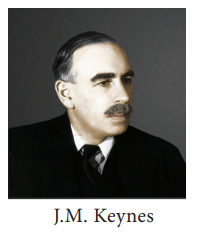
According
to Keynes, interest is purely a monetary phenomenon because the rate of
interest is calculated in terms of money. To him, “interest is the reward for
parting with liquidity for a specified period of time”.
Meaning of Liquidity Preference
Liquidity
preference means the preference of the people to hold wealth in the form of
liquid cash rather than in other non-liquid assets like bonds, securities,
bills of exchange, land, building, gold etc.
“Liquidity Preference is the preference to have an amount of
cash rather than of claims against others”.
-Meyer
Motives of Demand for Money
According
to Keynes, there are three
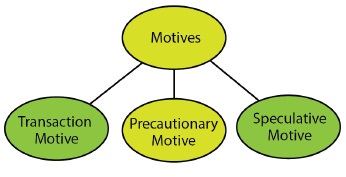
1. The Transaction Motive
The
transaction motive relates to the desire of the people to hold cash for the
current transactions (or day–to-day expenses).
The
amount saved under this motive depends on the level of income. Mt and Y are
positively associated. (Say Mt = 0.125Y; that means if income is Rs. 1000, demand for transaction motive is Rs. 125)
2. The Precautionary Motive
The
precautionary motive relates to the desire of the people to hold cash to meet
unexpected or unforeseen expenditures such as sickness, accidents, fire and
theft. The amount saved for this motive also depends on the level of income.
(Say Mp = 0.125Y; it means if income is Rs. 1000, demand for Mp is Rs. 125)
Mp = f (y)
3. The Speculative Motive
The
speculative motive relates to the desire of the people to hold cash in order to
take advantage of market movements regarding the future changes in the price of
bonds and securities in the capital market. The amount saved for this motive
depends on the rate of interest. Ms = f (i). There is inverse relation between
liquidity preference and rate of interest (Say Ms = 450-100i).
Determination of Rate of Interest
According
to Keynes, the rate of interest is determined by the demand for money and the
supply of money. The demand for money is liquidity preference. In fact,
liquidity preference for speculative motive determines rate of interest. The
supply of money is determined by the policies of the Government and the Central
Bank of a country. The total supply of money consists of coins, currency notes
and bank deposits (Say M = 200).
Equilibrium between Demand and Supply of Money
The equilibrium between liquiditypreference
and demand for money determine the rate of interest. In short -run, the supply
of money is assumed to be constant ( Rs. 200).
LP is the
liquidity preference Curve (demand curve). M2 M2 shows the supply curve of
money to satisfy speculative motive. Both curves intersect at the point E,
which is the equilibrium point. Hence, the rate of interest is 2.5. If
liquidity preference increases from LP to L1P1 the supply of money remains
constant, the rate of interest would increase from OI to OI1. Numerical
examples given above can also be used for better understanding. Total demand
for money=Mt+Mp+Ms =0.125Y+0.125Y+(450- 100i).
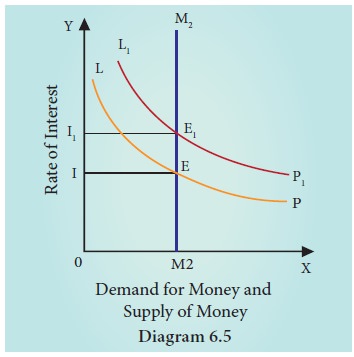
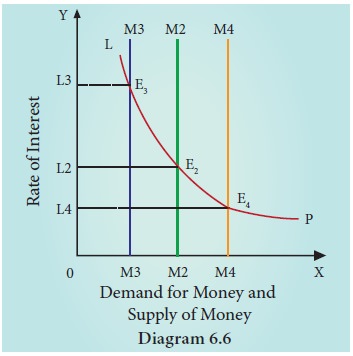
Total
supply of money= Rs. 200. Mt and Mp are influenced by Y. Hence for the sake of
easy understanding, Ms alone can be considered Demand for money=supply of money
at equilibrium point:450-100i=200;450 - 200=100i;250=100i; i=250/100=2.5.This
is equilibrium interest In reality, interest rate is also influenced by
national income and commodity sector equilibrium.However, they are not included
here for making the understanding easier.
Suppose
LP remains constant. If the supply of money is OM2, the interest is
OI2 and if the supply of money is reduced from OM2 to OM3,
the interest would increase from OI2 to OI3. If the
supply of money is increased from OM2 to OM4, the
interest would decrease from OI2 to OI4.
Criticisms
This
theory does not explain the existence of different interest rates prevailing in
the market at the same time.
It
explains interest rate only in the short-run.
Related Topics